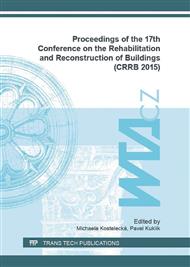p.44
p.51
p.59
p.64
p.72
p.78
p.86
p.90
p.95
Development of Lightweight, Remediation Plasters and Study of their Moisture Behavior
Abstract:
One of the strategic goals of Europe 2020 is the reduction of greenhouse gas emissions by 20 % by 2020 compared to year 1990 and increasing energy efficiency by 20 %. Closely related to the revitalization of structures necessary for reasons reduction of their unsatisfactory energy consumption and then also the construction of new building structures with minimal energy requirements by using less energy demanding materials, if is it possible from easily renewable resources. Currently, the structures involved a high degree of total energy consumption in the European Union, about 40 %. Thermal insulating plasters with using lightweight aggregate based on recycled glass are the appropriate remediation materials for the rehabilitation of existing buildings, or even for thermal insulation of new structures. In view of the fact that historic buildings are often exposed to dampness and moisture, it is necessary for these redevelopment plasters also tackle studios moisture transport. The paper describes the results of the development of new insulating plasters that would have been reflected particularly in the rehabilitation of historic buildings and problematic details of building structures.
Info:
Periodical:
Pages:
72-77
Citation:
Online since:
September 2016
Authors:
Price:
Сopyright:
© 2016 Trans Tech Publications Ltd. All Rights Reserved
Share:
Citation:


